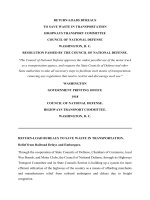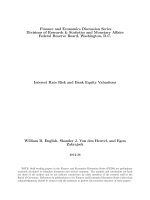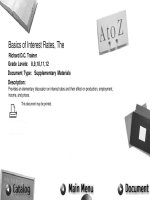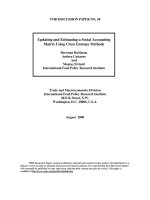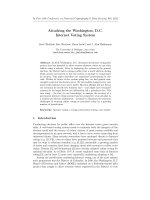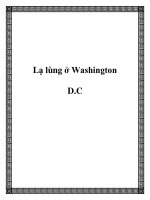Attacking the Washington, D.C. Internet Voting System pot
Bạn đang xem bản rút gọn của tài liệu. Xem và tải ngay bản đầy đủ của tài liệu tại đây (2.15 MB, 18 trang )
In Proc. 16th Conference on Financial Cryptography & Data Security, Feb. 2012
Attacking the Washington, D.C.
Internet Voting System
Scott Wolchok, Eric Wustrow, Dawn Isabel, and J. Alex Halderman
The University of Michigan, Ann Arbor
{swolchok,ewust,dki,jhalderm}@umich.edu
Abstract.
In 2010, Washington, D.C. developed an Internet voting pilot
project that was intended to allow overseas absentee voters to cast their
ballots using a website. Prior to deploying the system in the general
election, the District held a unique public trial: a mock election during
which anyone was invited to test the system or attempt to compromise
its security. This paper describes our experience participating in this
trial. Within 48 hours of the system going live, we had gained near-
complete control of the election server. We successfully changed every vote
and revealed almost every secret ballot. Election officials did not detect
our intrusion for nearly two business days —and might have remained
unaware for far longer had we not deliberately left a prominent clue. This
case study— the first (to our knowledge) to analyze the security of a
government Internet voting system from the perspective of an attacker in
a realistic pre-election deployment—attempts to illuminate the practical
challenges of securing online voting as practiced today by a growing
number of jurisdictions.
Keywords: Internet voting, e-voting, penetration testing, case studies
1 Introduction
Conducting elections for public office over the Internet raises grave security
risks. A web-based voting system needs to maintain both the integrity of the
election result and the secrecy of voters’ choices, it must remain available and
uncompromised on an open network, and it has to serve voters connecting from
untrusted clients. Many security researchers have cataloged threats to Internet
voting (e.g. [
11
,
15
]), even as others have proposed systems and protocols that
may be steps to solutions someday (e.g. [
6
,
12
]); meanwhile, a growing number
of states and countries have been charging ahead with systems to collect votes
online. Estonia [
1
] and Switzerland [
2
] have already adopted online voting for
national elections. As of 2010, 19 U.S. states employed some form of Internet
voting [5], and at least 12 more were reportedly considering adopting it [4].
Among the jurisdictions considering Internet voting, one of the most enthusi-
astic proponents was the District of Columbia. In 2010, the Washington, D.C.
Board of Elections and Ethics (BOEE) embarked on a Federally-funded pilot
project that sought to allow overseas voters registered in the District to vote
2 Scott Wolchok et al.
over the web starting with the November 2010 general election [
16
]. Though the
D.C. system, officially known as the “D.C. Digital Vote-by-Mail Service,” was
technologically similar to parallel efforts in other states, BOEE officials adopted a
unique and laudable level of transparency. The system was developed as an open
source project, in partnership with the nonprofit Open Source Digital Voting
(OSDV) Foundation [
3
]. Most significantly, prior to collecting real votes with the
system, the District chose to operate a mock election and allow members of the
public to test its functionality and security.
We participated in this test, which ran for four days in September and October
2010. Our objective was to approach the system as real attackers would: starting
from publicly available information, we looked for weaknesses that would allow
us to seize control, unmask secret ballots, and alter the outcome of the mock
election. Our simulated attack succeeded at each of these goals and prompted
the D.C. BOEE to discontinue its plans to deploy digital ballot return in the
November election.
In this paper, we provide a case study of the security of an Internet voting
system that, absent our participation, might have been deployed in real elections.
Though some prior investigations have analyzed the security of proposed Internet
voting systems by reviewing their designs or source code, this is the first instance
of which we are aware where researchers have been permitted to attempt attacks
on such a system in a realistic deployment intended for use in a general election.
We hope our experiences with the D.C. system will aid future research on
secure Internet voting. In particular, we address several little-understood practical
aspects of the problem, including the exploitability of implementation errors in
carefully developed systems and the ability of election officials to detect, respond,
and recover from attacks. Our successful penetration supports the widely held
view among security researchers that web-based electronic voting faces high risks
of vulnerability, and it cautions against the position of many vendors and election
officials who claim that the technology can readily be made safe.
The remainder of this paper is organized as follows: Section 2 introduces the
architecture and user interface of the Digital Vote-By-Mail System. In Section 3,
we describe how we found and exploited vulnerabilities in the web application soft-
ware to compromise the mock election. Section 4 describes further vulnerabilities
that we found and exploited in low-level network components. Section 5 discusses
implications of our case study for other Internet voting systems and future public
trials. We survey related work in Section 6 and conclude in Section 7.
2 Background: The D.C. Digital Vote-By-Mail System
Architecture The Digital Vote-by-Mail (DVBM) system is built around an open-
source web application
1
developed in partnership with the D.C. BOEE by the
OSDV Foundation’s TrustTheVote project
2
. The software uses the popular Ruby
on Rails framework and is hosted on top of the Apache web server and the
1
/>2
Attacking the Washington, D.C. Internet Voting System 3
Allowed TCP ports : 80 and 443
Allowed TCP port : 80
Web Server Application Server Database Server
Public Network
digital-vbm.dc.gov
Firewall and
Intrusion Detection
Firewall
Fig. 1:
Network architecture
— The front-end web server receives HTTPS
requests from users and reverse-proxies them to the application server, which
hosts the DVBM election software and stores both blank and completed ballots. A
MySQL database server stores voter credentials and tracks voted ballots. Multiple
firewalls reduce the attack surface and complicate attacks by disallowing outbound
TCP connections. The intrusion detection system in front of the web server proved
ineffective, as it was unable to decrypt the HTTPS connections that carried our
exploit. (Adapted from />MySQL relational database. Global election state (such as registered voters’
names, addresses, hashed credentials, and precinct-ballot mappings, as well as
which voters have voted) is stored in the MySQL database. Voted ballots are
encrypted and stored in the filesystem. User session state, including the user ID
and whether the ballot being cast is digital or physical, is stored in an encrypted
session cookie on the user’s browser.
Electronic ballots are served as PDF files which voters fill out using a PDF
reader and upload back to the server. To safeguard ballot secrecy, the server
encrypts completed ballots with a public key whose corresponding private key is
held offline by voting officials. Encrypted ballots are stored on the server until
after the election, when officials transfer them to a non-networked computer (the
“crypto workstation”), decrypt them using the private key, and print them for
counting alongside mail-in absentee ballots.
Figure 1 shows the network architecture deployed for the mock election.
HTTPS web requests are interpreted by the web server over TCP port 443.
The web server then performs the HTTP request on the user’s behalf to the
application server, which runs the DVBM application software. The web server,
application server, and a MySQL database server all run Linux. Firewalls prevent
outbound connections from the web and application servers. Since the web server
and application server run on separate machines, a compromise of the application
server will not by itself allow an attacker to steal the HTTPS private key.
Voter experience The DVBM system was intended to be available to all military
and overseas voters registered in the District. Months prior to the election, each
eligible voter received a letter by postal mail containing credentials for the system.
These credentials contained the voter ID number, registered name, residence ZIP
code, and a 16-character hexadecimal personal identification number (PIN). One
4 Scott Wolchok et al.
(a) Select online or postal voting
(b) Overview of steps
(c) Authenticate with voter ID / PIN
(d) “Affirm” identity
(e) Download blank ballot
(f) Mark ballot in PDF reader and save
(g) Upload completed ballot
(h) “Thank you” screen
Fig. 2:
Screenshots of the D.C. voting system
show a typical voter’s work-
flow. After opting to digitally return the ballot (a), the voter receives instructions
(b) then enters credentials provided by postal mail (c) and attests to his identity
(d). He then downloads a PDF file of the ballot (e), selects candidates and saves
the file (f ), and uploads the completed ballot to the server (g), which returns a
confirmation screen (h).
Attacking the Washington, D.C. Internet Voting System 5
instance of this letter is shown in Figure 5. The letters instructed voters to visit
the D.C. Internet voting system website, which guided them through the voting
process.
Figure 2 depicts the steps of the online voting user interface. Upon arrival,
the voter selects between a digital or postal ballot return. Next, the voter is
presented with an overview of the voting process. The voter then logs in with
the credentials provided in the mail, and confirms his or her identity. Next, the
voter is presented with a blank ballot in PDF format. In the postal return option,
the voter simply prints out the ballot, marks it, and mails it to the provided
address. For the digital return, the voter marks the ballot electronically using a
PDF reader, and saves the ballot to his or her computer. The voter then uploads
the marked ballot to the D.C. Internet voting system, which reports that the
vote has been recorded by displaying a “Thank You” page. If voters try to log in
a second time to cast another ballot, they are redirected to the final Thank You
page, disallowing them from voting again.
3 Attacking the Web Application
In this section, we describe vulnerabilities we discovered and exploited in the
DVBM server application. Our search for vulnerabilities was primarily conducted
by manual inspection of the web application’s source code, guided by a focus
on the application’s attack surface. In particular, we concentrated on voter
login, ballot upload and handling, database communication, and other network
activity. The fact that the application was open source expedited our search, but
motivated attackers could have found vulnerabilities without the source code
using alternative methods. For example, one might attack voter login fields, ballot
contents, ballot filenames, or session cookies, by either fuzzing or more direct
code injection attacks such as embedding snippets of SQL, shell commands, and
popular scripting languages with detectable side effects.
3.1 Shell-injection vulnerability
After a few hours of examination, we found a shell injection vulnerability that
eventually allowed us to compromise the web application server. The vulnerability
was located in the code for encrypting voted ballots uploaded by users. The
server stores uploaded ballots in a temporary location on disk, and the DVBM
application executes the
gpg
command to encrypt the file, using the following
code:
run ( "gpg" , "−−t r us t −model always −o
\"#{ F i le . expand_path ( dst . path ) }\" −e −r
\"#{ @r ec ip ie nt }\" \"#{ F i le . expand_path ( s r c . path ) }\" " )
The
run
method invoked by this code concatenates its first and second
arguments, collapses multiple whitespace characters into single characters, and
then executes the command string using Ruby’s backtick operator, which passes
6 Scott Wolchok et al.
the provided command to the shell. The Paperclip
3
Rails plugin, which the
application uses to handle file uploads, preserves the extension of the uploaded
ballot file, and no filtering is performed on this extension, so the result of
File.expand_path(src.path)
is attacker controlled. Unfortunately, in the Bash
shell used on the server, double quotes do not prevent the evaluation of shell
metacharacters, and so a ballot named
foo.$(cmd)
will result in the execution
of cmd with the privileges of the web application.
The current release of the Paperclip plugin at the time of our analysis (late
September 2010) was version 2.3.3. It appears that a similar vulnerability in
Paperclip’s built-in
run
method was fixed on April 30, 2010
4
. The first release
containing the patch was version 2.3.2, which was tagged in the Paperclip
Git repository on June 8, 2010. The degree of similarity between the DVBM
application’s custom
run
method and the Paperclip
run
method suggests that
the DVBM application’s implementation is a custom “stripped-down” version
of Paperclip’s, contrary to the D.C. BOEE’s assertion that “a new version of
[Paperclip] that had not been fully tested had been released and included in
the deployed software” and “did not perform filename checks as expected.” [
14
]
Indeed, if DVBM had used the Paperclip
run
method together with an up-to-date
version of the Paperclip library, this specific vulnerability would not have been
included in the software. The resulting attack serves as a reminder that a small,
seemingly minor engineering mistake in practically any layer of the software stack
can result in total system compromise.
When we tested the shell injection vulnerability on the mock election server,
we discovered that outbound network traffic from the test system was filtered,
rendering traditional shellcode and exfiltration attempts (e.g.,
nc umich.edu
1234 < /tmp/ballot.pdf
) ineffective. However, we were able to exfiltrate data
by writing output to the
images
directory on the compromised server, where
it could be retrieved with any HTTP client. To expedite crafting our shell
commands, we developed an exploit compiler and a shell-like interface that, on
each command, creates a maliciously named ballot file, submits the ballot to the
victim server, and retrieves the output from its chosen URL under /images.
Interestingly, although the DVBM system included an intrusion detection
system (IDS) device, it was deployed in front of the web server and was not
configured to intercept and monitor the contents of the encrypted HTTPS
connections that carried our attack. Although configuring the IDS with the
necessary TLS certificates would no doubt have been labor intensive, failure to
do so resulted in a large “blind spot” for the D.C. system administrators.
3.2 Attack payloads
We exploited the shell injection vulnerability to carry out several attacks that
illustrate the devastating effects attackers could have during a real election if
they gained a similar level of access:
3
/>4
The patch in question is available at />commit/724cc7. It modifies
run
to properly quote its arguments using single quotes.
Attacking the Washington, D.C. Internet Voting System 7
Stealing secrets We retrieved several cryptographic secrets from the application
server, including the public key used for encrypting ballots. Despite the use of
the term “public key,” this key should actually be kept secret, since it allows
attackers to substitute arbitrary ballots in place of actual cast ballots should
they gain access to the storage device. We also gained access to the database
by finding credentials in the bash history file (
mysql -h 10.1.143.75 -udvbm
-pP@ssw0rd).
Changing past and future votes We used the stolen public key to replace all of
the encrypted ballot files on the server at the time of our intrusion with a forged
ballot of our choosing. In addition, we modified the ballot-processing function to
append any subsequently voted ballots to a
.tar
file in the publicly accessible
images
directory (where we could later retrieve them) and replace the originals
with our forged ballot. Recovery from this attack is difficult; there is little hope
for protecting future ballots from this level of compromise, since the code that
processes the ballots is itself suspect. Using backups to ensure that compromises
are not able to affect ballots cast prior to the compromise may conflict with
ballot secrecy in the event that the backup itself is compromised.
Revealing past and future votes One of the main goals of a voting system is
to protect ballot secrecy, which means not only preventing an attacker of the
system from determining how a voter voted, but also preventing a voter from
willingly revealing their cast ballot to a third party, even if they are coerced or
incentivized to do so. While any absentee system that allows voters to vote where
they choose allows a voter to reveal his or her vote voluntarily, our attack on the
D.C. system allowed us to violate ballot secrecy and determine how nearly all
voters voted.
Our modifications to the ballot processing function allowed us to learn the
contents of ballots cast following our intrusion. Revealing ballots cast prior to
our intrusion was more difficult, because the system was designed to store these
ballots in encrypted form, and we did not have the private key needed to decipher
them. However, we found that the Paperclip Rails plugin used to handle file
uploads stored each ballot file in the
/tmp
directory before it was encrypted. The
web application did not remove these unencrypted files, allowing us to recover
them. While these ballots do not explicitly specify the voter’s ID, they do indicate
the precinct and time of voting, and we were able to associate them with voters
by using login events and ballot filenames recorded in the server application logs.
Thus, we could violate the secret ballot for past and future voters.
Discovering that real voter credentials were exposed In addition to decrypted
ballots, we noticed that the
/tmp
directory also contained uploaded files that
were not PDF ballots but other kinds of files apparently used to exercise error
handling code during testing. To our surprise, one of these files was a 937 page
PDF document that contained the instruction letters sent to each of the registered
voters, which included the real voters’ credentials for using the system. The first
page of this file is shown in Figure 5. These credentials would have allowed us (or
anyone else who penetrated the insecure server) to cast votes as these citizens in
8 Scott Wolchok et al.
Fig. 3:
Musical “calling card”
— We modified the Thank You page that appears
at the end of the voting process to play the University of Michigan fight song,
“The Victors.” Nevertheless, it took two business days for officials to become
aware of the infiltration. Our additions appear on lines 68–70 above.
the real D.C. election that was to begin only days after the test period. Since the
system requires that these credentials be delivered via postal mail, it would be
infeasible for officials to send updated ones to the voters in time for the election.
Hiding our tracks We were able to hide the evidence of our intrusion with
moderate success. We downloaded the DVBM application logs, altered them to
remove entries corresponding to our malicious ballot uploads, and, as our final
actions, overwrote the application log with our sanitized version and removed
our uploaded files from the /tmp and images directories.
Our calling card To make our control over the voting system more tangible
to nontechnical users, we left a “calling card” on the final screen of the digital
voting workflow: we uploaded a recording of “The Victors” (the University of
Michigan fight song) and modified the confirmation page to play this recording
after several seconds had elapsed, as shown in Figure 3. We hoped that this
would serve as a clear demonstration that the site had been compromised, while
remaining discreet enough to allow the D.C. BOEE system administrators a
chance to exercise their intrusion detection and response procedures.
3.3 Other vulnerabilities and potential attacks
Our intention in participating in the trial was to play the role of a real attacker.
Therefore, once we had found vulnerabilities that allowed us to compromise the
system, our attention shifted to understanding and exploiting these problems.
However, along the way we did uncover several additional vulnerabilities in the
Attacking the Washington, D.C. Internet Voting System 9
DVBM web application that were not necessary for our attack. Two key system
deployment tasks were not completed. First, the set of test voter credentials
was not regenerated and was identical to those included in the public DVBM
Git repository. While the test voter credentials were fictitious, their disclosure
constituted a security problem because public testers were asked to contact the
D.C. BOEE for credentials, implying that the number of credentials available to
each test group was to be limited.
Similarly, the encryption key used for session cookies was unchanged from
the default key published in the repository. Disclosure of the key exacerbated a
second vulnerability: rather than using the Rails-provided random
session_id
to associate browser sessions with voter credentials, the DVBM developers used
the
rid
value, which corresponds to the automatically incremented primary key
of the registration table in the system’s MySQL database. This means every
integer less than or equal to the number of registered voters is guaranteed to
correspond to some voter. Combining this with the known encryption key results
in a session forgery vulnerability. An attacker can construct a valid cookie for
some voter simply by choosing an arbitrary valid
rid
value. This vulnerability
could have been used to submit a ballot for every voter.
Our attack was expedited because the DVBM application user had permission
to write the code of the web application. Without this permission, we would
have had to find and exploit a local privilege escalation vulnerability in order
to make malicious changes to the application. In fact, the version of the Linux
kernel running on the application server (2.6.18-194.11.4.el5) had a known local
root exploit (CVE-2010-3081) that could have allowed us to gain root privileges
on the machine. As we were able to carry out our attacks as the web application
user, we did not need to use this exploit.
We also identified other attack strategies that we ultimately did not need to
pursue. For instance, the “crypto workstation” (see Section 2) used for decrypting
and tabulating ballots is not directly connected to the Internet, but attackers
may be able to compromise it by exploiting vulnerabilities in PDF processing
software. PDF readers are notoriously subject to security vulnerabilities; indeed,
the Crypto Workstation’s lack of Internet connectivity may reduce its security
by delaying the application of automated updates in the time leading up to
the count. If the Crypto Workstation is compromised, attackers would likely be
able to rewrite ballots. Furthermore, the web application allowed uploaded PDF
ballots to contain multiple pages. If the printing is done in an automated fashion
without restricting printouts to a single page, an attacker could vote multiple
ballots.
4 Attacking the Network Infrastructure
In addition to the web application server, we were also able to compromise
network infrastructure on the pilot network. This attack was independent from
our web application compromise, yet it still had serious ramifications for the real
election and showed a second potential path into the system.
10 Scott Wolchok et al.
Prior to the start of the mock election, the D.C. BOEE released a pilot
network design diagram that showed specific server models, the network con-
figuration connecting these servers to the Internet, and a CIDR network block
(8.15.195.0/26). Using Nmap, we discovered five of the possible 64 addresses in
this address block to be responsive. By using Nmap’s OS fingerprinting feature
and manually following up with a web browser, we were able to discover a Cisco
router (8.15.195.1), a Cisco VPN gateway (8.15.195.4), two networked webcams
(8.15.195.11 and 8.15.195.12), and a Digi Passport 8 terminal server
5
(8.15.195.8).
4.1 Infiltrating the terminal server
The Digi Passport 8 terminal server provides an HTTP-based administrative
interface. We were able to gain access using the default root password (
dbps
)
obtained from an online copy of the user manual. We found that the terminal
server was connected to four enterprise-class Cisco switches (which we surmised
corresponded to the switches shown on the network diagram provided by the
BOEE) and provided access to the switches’ serial console configuration interfaces
via telnet.
We hid our presence in the terminal server using a custom JavaScript rootkit,
which we installed over an SSH session (the same account names and passwords
used in the web interface were accepted for SSH). The rootkit concealed an
additional account with administrator privileges, “dev,” which we planned to use
in case our attack was discovered and the passwords changed. We also used our
SSH access to download the terminal server’s
/etc/shadow
and
/etc/passwd
files
for cracking using the “John the Ripper” password cracker
6
. After about 3.5 hours
using the cracker’s default settings, we recovered the secondary administrator
password cisco123 from a salted MD5 hash.
Evidence of other attackers When we inspected the terminal server’s logs, we
noticed that several other attackers were attempting to guess the SSH login
passwords. Such attacks are widespread on the Internet, and we believe the
ones we observed were not intentionally directed against the D.C. voting system.
However, they provide a reminder of the hostile environment in which Internet
voting applications must operate.
The first SSH attack we observed came from an IP address located in Iran
(80.191.180.102), belonging to Persian Gulf University. We realized that one of
the default logins to the terminal server (user:
admin
, password:
admin
) would
likely be guessed by the attacker in a short period of time, and therefore decided
to protect the device from further compromise that might interfere with the
voting system test. We used iptables to block the offending IP addresses and
changed the admin password to something much more difficult to guess. We later
blocked similar attacks from IP addresses in New Jersey, India, and China.
5
A terminal server is a device that attaches to other pieces of equipment and allows
administrators to remotely log in and configure them.
6
/>Attacking the Washington, D.C. Internet Voting System 11
4.2 Routers and switches
After we compromised the terminal server, we found several devices connected to
its serial ports. Initially, there were four Cisco switches: a pair of Nexus 5010s
and a pair of Nexus 7010s. Connecting to these serial ports through the terminal
server presented us with the switches’ login prompts, but previously found and
default passwords were unsuccessful.
The terminal server provided built-in support for keystroke logging of serial
console sessions and forwarding of logged keystrokes to a remote syslog server,
which we enabled and configured to forward to one of our machines. This allowed
us to observe in real time as system administrators logged in and configured the
switches, and to capture the switches’ administrative password, !@#123abc.
Later in the trial, four additional devices were attached to the terminal server,
including a pair of Cisco ASR 9010 routers and a pair of Cisco 7606-series routers.
We were again able to observe login sessions and capture passwords. At the
end of the public trial, we changed the passwords on the routers and switches—
effectively locking the administrators out of their own network — before alerting
BOEE officials and giving them the new password.
D.C. officials later told us that the routers and switches we had infiltrated were
not intended to be part of the voting system trial and were simply colocated with
the DVBM servers at the District’s off-site testing facility. They were, however,
destined to be deployed in the core D.C. network, over which real election traffic
would flow. With the access we had, we could have modified the devices’ firmware
to install back doors that would have given us persistent access, then later
programmed them to redirect Internet voting connections to a malicious server.
4.3 Network webcams
We found a pair of webcams on the DVBM network — both publicly accessible
without any password—that showed views of the server room that housed the
pilot. As shown in Figure 4, one camera pointed at the entrance to the room, and
we were able to observe several people enter and leave, including a security guard,
several officials, and IT staff new hardware. The second camera was directed at
a rack of servers.
These webcams may have been intended to increase security by allowing
remote surveillance of the server room, but in practice, since they were unsecured,
they had the potential to leak information that would be extremely useful
to attackers. Malicious intruders viewing the cameras could learn which server
architectures were deployed, identify individuals with access to the facility in order
to mount social engineering attacks, and learn the pattern of security patrols in
the server room. We used them to gauge whether the network administrators had
discovered our attacks —when they did, their body language became noticeably
more agitated.
12 Scott Wolchok et al.
(a) Voting server rack
(c) Typical workers, before attack
(b) Security guard
(d) Workers, after learning of attack
Fig. 4:
Unsecured network surveillance cameras
gave us a real-time view
into the network operations center. We could observe whether administrators
made physical changes to the servers running the voting system (a) and monitor
the frequency of patrols by security guards (b). We inferred that our attack had
not been detected based on the relaxed body language of workers in the facility,
e.g. (c), which changed dramatically after the BOEE learned of our intrusion (d).
5 Discussion
5.1 Attack detection and recovery
After we completed our attack —including our musical calling card on the “Thank
You” page — there was a delay of approximately 36 hours before election officials
responded and took down the pilot servers for analysis. The attack was apparently
brought to officials’ attention by an email on a mailing list they monitored that
curiously asked, “does anyone know what tune they play for successful voters?”
Shortly after another mailing list participant recognized the music as “The
Victors,” officials abruptly suspended the public examination period, halting the
tests five days sooner than scheduled, citing “usability issues.”
Following the trial, we discussed the attack with D.C. officials. They explained
that they found our modifications to the application code by comparing the disk
image of the server to a previous snapshot, although this required several days
of analysis. They confirmed that they were unable to see our attacks in their
intrusion detection system logs, that they were unable to detect our presence
in the network equipment until after the trial, and that they did not discover
the attack until they noticed our intentional calling card. We believe that attack
Attacking the Washington, D.C. Internet Voting System 13
detection and recovery remain significant challenges for any Internet voting
system.
5.2 Adversarial testing and mechanics of the D.C. trial
The D.C. BOEE should be commended for running a public test of their system.
Their trial was a step in the right direction toward transparency in voting tech-
nology and one of the first of its kind. Nonetheless, we reiterate that adversarial
testing of Internet voting applications is not necessary to show that they are
likely to be weak. The architectural flaws inherent in Internet voting systems in
general and the potential disastrous implications of a single vulnerability were
known and expected by researchers prior to the D.C. trial [
11
]. We hope not to
have to repeat this case study in order to highlight these limitations once again.
The key drawback to adversarial testing is that a lack of problems found in
testing does not imply a lack of problems in the system, despite popular perception
to the contrary. It is likely that testers will have more limited resources and
weaker incentives than real attackers —or they may simply be less lucky. A
scarcity of testers also seems to have been an issue during the D.C. trial. During
our compromise of the DVBM server, we were able to view the web access logs,
which revealed only a handful of attack probes from other testers, and these were
limited to simple failed SQL and XSS injection attempts.
One reason for the lack of participation may have been ambiguity over the
legal protections provided to testers by the BOEE. Another possible reason is
that the test began on short notice— the final start date was announced only
three days in advance. If such a trial must be repeated, we hope that the schedule
will be set well in advance, and that legal protections for participants will be
strongly in place. In addition to the short notice, the scheduled conclusion of the
test was only three days before the system was planned to be opened for use
by real voters. Had the test outcome been less dramatic, election officials would
have had insufficient time to thoroughly evaluate testers’ findings.
Despite these problems, one of the strongest logistical aspects of the D.C.
trial was that access to the code —and to some extent, the architecture — was
available to the testers. While some observers have suggested that this gave us
an unrealistic advantage while attacking the system, there are several reasons
why such transparency makes for a more realistic test. Above and beyond the
potential security benefits of open source code (pressure to produce better code,
feedback from community, etc.), in practice it is difficult to prevent a motivated
attacker from gaining access to source code. The code could have been leaked by
the authors through an explicit sale by dishonest insiders, as a result of coercion,
or through a compromised developer workstation. Since highly plausible attacks
such as these are outside the scope of a research evaluation, it is not only fair
but realistic to provide the code to the testers.
5.3 Why Internet voting is hard
Practical Internet voting designs tend to suffer from a number of fundamental
difficulties, from engineering practice to inherent architectural flaws. We feel it is
14 Scott Wolchok et al.
important to point them out again given the continued development of Internet
voting systems.
Engineering practice Both the DVBM system and the earlier prototype Inter-
net voting system SERVE [
11
] were built primarily on commercial-off-the-shelf
(COTS) software (which, despite the use of the term “commercial,” includes most
everyday open-source software). Unfortunately, the primary security paradigm for
COTS developers is still “penetrate and patch.” While this approach is suitable
for the economic and risk environment of typical home and business users, it is
not appropriate for voting applications due to the severe consequences of failure.
Inherited DRE threats Relatively simple Internet voting systems like D.C.’s
DVBM strongly resemble direct recording electronic (DRE) voting machines,
in that there is no independent method for auditing cast ballots. If the voting
system software is corrupt, recovery is likely to be impossible, and even detection
can be extremely difficult. DRE voting is highly susceptible to insider attacks
as well as external compromise through security vulnerabilities. In previous
work [7,8,10,13,17], the closed, proprietary nature of DREs has been held as an
additional threat to security, since there is no guarantee that even the intended
code is honest and correct. In contrast, the DVBM system was open source, but
the public would have had no guarantee that the deployed voting system was
actually running the published code.
Tensions between ballot secrecy and integrity One of the fundamental reasons
that voting systems are hard to develop is that two fundamental goals of a secret
ballot election— ballot secrecy and ballot integrity — are in tension. Indeed, the
D.C. system attempted to protect integrity through the use of logs, backups and
intrusion detection, yet these systems can help an intruder compromise ballot
secrecy. Other security mechanisms put in place to protect ballot secrecy, such as
encrypting completed ballots and avoiding incremental backups make detecting
and responding to compromise much more difficult.
Architectural brittleness in web applications The main vulnerability we exploited
resulted from a tiny oversight in a single line of code and could have been
prevented by using single quotes instead of double quotes. Mistakes like this are
all too common. They are also extremely hard to eradicate, not because of their
complexity, but because of the multitude of potential places they can exist. If any
one place is overlooked, an attacker may be able to leverage it to gain control
of the entire system. In this sense, existing web application frameworks tend to
be brittle. As our case study shows, the wrong choice of which type of quote
to use— or countless other seemingly trivial errors —can result in an attacker
controlling the outcome of an election.
Internet-based threats Internet voting exposes what might otherwise be a small,
local race of little global significance to attackers from around the globe, who may
act for a wide range of reasons varying from politics to financial gain to sheer
malice. In addition to compromising the central voting server as we did, attackers
can launch denial-of-service attacks aimed at disrupting the election, they can
Attacking the Washington, D.C. Internet Voting System 15
redirect voters to fake voting sites, and they can conduct widespread attacks on
voters’ client machines [
9
]. These threats correspond to some of the most difficult
unsolved problems in Internet security and are unlikely to be overcome soon.
Comparison to online banking While Internet-based financial applications, such
as online banking, share some of the threats faced by Internet voting, there is
a fundamental difference in ability to deal with compromises after they have
occurred. In the case of online banking, transaction records, statements, and
multiple logs allow customers to detect specific fraudulent transactions and in
many cases allow the bank to reverse them. Internet voting systems cannot keep
such fine-grained transaction logs without violating ballot secrecy for voters.
Even with these protections in place, banks suffer a significant amount of online
fraud but write it off as part of the cost of doing business; fraudulent election
results cannot be so easily excused.
6 Related Work
Although this is, to the best of our knowledge, the first public penetration test
of an Internet voting system scheduled for use in a general election, we are not
the first to caution against the adoption of Internet voting.
The most closely related work is the 2004 security analysis of the Secure
Electronic Registration and Voting Experiment (SERVE) by Jefferson et al. [
11
].
Like the D.C. DVBM project, SERVE was an Internet voting “pilot” that was
slated for use in an actual election by absentee overseas voters. Jefferson et al. re-
viewed the system design and pointed out many architectural and conceptual
weaknesses that apply to remote Internet voting systems in general, though they
did not have an opportunity to conduct a penetration test of a pilot system. On
the basis of these weaknesses, Jefferson et al. recommended “shutting down the
development of SERVE immediately and not attempting anything like it in the
future until both the Internet and the world’s home computer infrastructure have
been fundamentally redesigned.” We emphatically reaffirm that recommendation.
Despite incremental advances in computer security in the last eight years, the
fundamental architectural flaws Jefferson et al. identified remain largely the same
to this day.
More recently, Esteghari and Desmedt [
9
] developed an attack on the Helios
2.0 [
6
] open-audit Internet voting system. Their attack exploits an architectural
weakness in home computer infrastructure by installing a “browser rootkit” or
“man-in-the-browser attack” that detects the ballot web page and modifies votes.
Esteghari and Desmedt note that Helios 3.0 is capable of posting audit information
to an external web server before ballot submission, which can, in theory, be checked
using a second trusted computer to detect the action of the rootkit, but it is not
clear that such a second computer will be available or a sufficiently large number
of nontechnical voters will take advantage of this audit mechanism.
16 Scott Wolchok et al.
7 Conclusions
Our experience with the D.C. pilot system demonstrates one of the key dangers in
many Internet voting designs: one small mistake in the configuration or implemen-
tation of the central voting servers or their surrounding network infrastructure
can easily undermine the legitimacy of the entire election. We expect that other
fielded Internet voting systems will fall prey to such problems, especially if they
are developed using standard practices for mass-produced software and websites.
Even if the central servers were somehow eliminated or made impervious to
external attack, Internet voting is likely to be susceptible to numerous classes of
threats, including sabotage from insiders and malware placed on client machines.
The twin problems of building secure software affordably and preventing home
computers from falling prey to malware attacks would both have to be solved
before systems like D.C.’s could be seriously considered. Although new end-to-end
verifiable cryptographic voting schemes have the potential to reduce the trust
placed in servers and clients, these proposals are significantly more advanced than
systems like D.C.’s and may prove even more difficult for developers and election
officials to implement correctly. Securing Internet voting in practice will require
significant fundamental advances in computer security, and we urge Internet
voting proponents to reconsider deployment until and unless major breakthroughs
are achieved.
Acknowledgments
We are grateful to the many people who helped make this work possible, including
Jeremy Epstein, Susannah Goodman, Nadia Heninger, David Jefferson, Bryan
Sivak, Pamela Smith, David Robinson, and especially Joseph Lorenzo Hall. We
thank the anonymous reviewers for their constructive feedback and Konstantin
Beznosov for shepherding this paper to publication. The authors also wish to
thank Rokey Suleman and Paul Stenbjorn of the D.C. BOEE for having the
courage to allow the public to test its voting system.
References
1.
Internet voting in Estonia. Vabariigi Valimiskomisjon. />dok/Internet_Voting_in_Estonia.pdf, Feb. 2007.
2.
Uncovering the veil on Geneva’s Internet voting solution. Republique Et Canton De
Geneve />SIDP_final_english.pdf, Feb. 2009.
3.
District of Columbia’s Board of Elections and Ethics adopts open source digital vot-
ing foundation technology to support ballot delivery. OSDV Press Release. http://
osdv.org/wp-content/uploads/2010/06/osdv-press-release-final-62210.pdf, June
2010.
4.
Internet voting, still in beta. The New York Times editorial. imes.
com/2010/01/28/opinion/28thu4.html, Jan. 2010.
5.
Internet voting. Verified Voting. ifiedvoting.org/article.php?list=
type&type=27, May 2011.
Attacking the Washington, D.C. Internet Voting System 17
6.
Adida, B. Helios: Web-based open-audit voting. In Proc. 17th USENIX Security
Symposium (July 2008).
7.
Appel, A. W., Ginsburg, M., Hursti, H., Kernighan, B. W., Richards,
C. D., Tan, G., and Venetis, P. The New Jersey voting-machine lawsuit and the
AVC Advantage DRE voting machine. In Proc. 2009 Electronic Voting Technology
Workshop/Workshop on Trustworthy Elections (EVT/WOTE) (Aug. 2009).
8.
Butler, K., Enck, W., Hursti, H., McLaughlin, S., Traynor, P., and
McDaniel, P. Systemic issues in the Hart InterCivic and Premier voting systems:
Reflections on project EVEREST. In Proc. 2008 Electronic Voting Technology
Workshop/Workshop on Trustworthy Elections (EVT/WOTE) (July 2008).
9.
Esteghari, S., and Desmedt, Y. Exploiting the client vulnerabilities in Internet
e-voting systems: Hacking Helios 2.0 as an example. In Proc. 2010 Electronic Voting
Technology Workship / Workshop on Trustworthy Elections (EVT/WOTE) (Aug.
2010).
10.
Feldman, A. J., Halderman, J. A., and Felten, E. W. Security analysis
of the Diebold AccuVote-TS voting machine. In Proc. 2007 Electronic Voting
Technology Workshop/Workshop on Trustworthy Elections (EVT/WOTE) (Aug.
2007).
11.
Jefferson, D., Rubin, A. D., Simons, B., and Wagner, D. A security
analysis of the secure electronic registration and voting experiment (SERVE).
Jan. 2004.
12.
Kiayias, A., Korman, M., and Walluck, D. An Internet voting system sup-
porting user privacy. In 22nd Annual Computer Security Applications Conference.
13.
Kohno, T., Stubblefield, A., Rubin, A. D., and Wallach, D. S. Analysis
of an electronic voting system. In IEEE Symposium on Security and Privacy (May
2004), pp. 27–40.
14.
Rokey W. Suleman, I., McGhie, K. W., Togo D. West, J., and Lowery,
C. Making reform a reality: An after-action report on implementation of the
Omnibus Election Reform Act. DCBOEE. />pdf_files/nr_687.pdf, Feb. 2011.
15.
Rubin, A. Security considerations for remote electronic voting over the Internet.
/>16.
Stenbjorn, P. An overview and design rationale memo. DCBOEE. http://
www.dcboee.us/dvm/DCdVBM-DesignRationale-v3.pdf, Sept. 2010.
17.
Wolchok, S., Wustrow, E., Halderman, J. A., Prasad, H. K., Kankipati,
A., Sakhamuri, S. K., Yagati, V., and Gonggrijp, R. Security analysis of
India’s electronic voting machines. In Proc. 17th ACM Conference on Computer
and Communications Security (CCS) (Oct. 2010).
18 Scott Wolchok et al.
DISTRICTOFCOLUMBIA
BOARDOFELECTIONSANDETHICS
4414
TH
STREETNW,SUITE250
WASHINGTON,D.C.20001Ͳ2745
D.C.OverseasDigitalVotebyMailService
DearHARRIETDANIEL:
YouhavebeenselectedtoparticipateintheDigitalVotebyMailinitiative.Aspartofits
implementationoftheMOVEAct,theDistrictofColumbiaBoardofElectionsandEthics
(BOEE)willofferoverseasvotersanoptiontoreceiveand,optionally,sendtheir
absenteeballotsdigitally.Whileyoumaychoosetoreturnyourabsenteeballotbymail
orfax,theBOEE’sDigitalVotebyMailprocessprovidesyouarapidreturnoptionthat
willmaintainballotsecrecyandintegrity.
TheWayitWorks
Approvedoverseasandmilitaryvoterswithinternetaccess,suchasyou,maylogonto
ourspecialdigitaldeliverywebsite.Inyourinternetbrowsertypein:
/>yourname,addressandpersonalidentificationnumber.Forsecuritypurposes,please
entertheinformationEXACTLYaslistedbelow.
VoterIDNumber:
YournameaslistedwithBOEE: HARRIETSANDRADANIEL
ResidenceZipCode: 20007
PersonalIdentificationNumber: BD15B35F1E3C4186
Ifyourinformationneedstobeupdated,pleasecontactourofficeseparatelybycalling
(202)727Ͳ2525orbyvisitingourwebsite.DONOTenter
updatedinformationintheDigitalVotebyMailwebsite.
OnceyougainaccesstotheDigitalVotebyMailsystem,onscreeninstructionswillstep
youthroughtheprocess.Atanypoint,youmaychoosetostopandreturnyourballot
byanothermethod.
Thankyouforyourparticipationinthishistoricvoterenfranchisementprocess,ifthis
pilotissuccessful,DigitalVotebyMailmaybeavailableinfutureelectionsand
communications,suchasthisletter,willbesentwellinadvanceoftheelection.
TheBOEEiscommittedtoprovidingaccuracy,transparency,andintegrityinelections
process.Ifyouhaveanyquestionsaboutthisprocess,pleasesendanemailmessageto
BestRegards,
D.C.BoardofElectionsandEthics
Fig. 5:
Voter instructions and credentials
— D.C. overseas voters received
letters like this, containing instructions and credentials for using the online voting
system. The letters, which were mailed prior to the pilot test, assert that the
system would “maintain ballot secrecy and integrity.” After we infiltrated the
pilot server, we discovered a PDF file, apparently uploaded during testing, that
contained all 937 letters sent to actual voters, including the secret credentials.
(This is the first page from that file; we have redacted the voter ID number for
privacy.) It would have been impossible for D.C. to provide new credentials to
all voters in time for the upcoming election.
